苏教版(凤凰)牛津英语教案6A-U6-A
- 格式:doc
- 大小:50.00 KB
- 文档页数:7
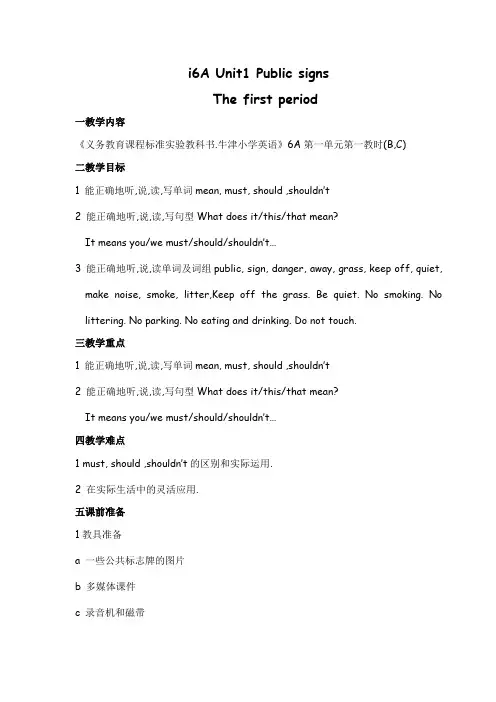
i6A Unit1 Public signsThe first period一教学内容《义务教育课程标准实验教科书.牛津小学英语》6A第一单元第一教时(B,C)二教学目标1 能正确地听,说,读,写单词mean, must, should ,shouldn’t2 能正确地听,说,读,写句型What does it/this/that mean?It means you/we must/should/shouldn’t…3 能正确地听,说,读单词及词组public, sign, danger, away, grass, keep off, quiet, make noise, smoke, litter,Keep off the grass. Be quiet. No smoking. No littering. No parking. No eating and drinking. Do not touch.三教学重点1 能正确地听,说,读,写单词mean, must, should ,shouldn’t2 能正确地听,说,读,写句型What does it/this/that mean?It means you/we must/should/shouldn’t…四教学难点1 must, should ,shouldn’t的区别和实际运用.2 在实际生活中的灵活应用.五课前准备1教具准备a 一些公共标志牌的图片b 多媒体课件c 录音机和磁带2 板书准备:预先写好课题6A Unit1 Public signs六教学过程A Free talkT: Excuse me. What’s your hobby?S1: I like watching TV.S2: I like going to the zoo.S3: I like surfing the Internet.T: Why do you like surfing the Internet?S3: Because I can know a lot of things from Internet. Such as animals, pictures and super stars.T: Cool. We can know a lot of things from Internet. And this boy: Jack, is looking at the public signs on the Internet.教授单词public, signB Presentation1 T: Please look at the public sign. Where can you see it?S1: I can see it in the hospital.S2: I can see it in the shopping center.S3: In the library.(启发学生做一个细心的,对生活处处留心的人,以培养学生的观察能力)T: All right. Thank you. And what does it mean? It means we should smoke.(边做吸烟的动作) Right or wrong?S: No, it means we shouldn’t smoke.T: Great! It means we shouldn’t smoke.(边说边板书,并教授单词)mean, smoke, should,shouldn’t2 让学生跟读句子并两人操练3 教授其他单词和词组.4 T: Boys and girls, let’s play a game: What’s missing?(利用游戏的方式,让学生在紧张又有限的时间内飞速记忆词汇,提高学习的效率,同时又不让学生觉得枯燥,厌烦)C Look and sayT: Can you remember these public signs?Ss: Yes.T: Great! You’re good students. And Jack is a good child. He learned a lot about public signs, too. Look, where are they now?S: They are in the zoo.T: What are they doing?S: They are talking about the public signs.T: Please choose one and talk about it with your partner.D PracticeT: Please look at the screen:The Summer Holiday is coming. Your cousin, Lucy will visit Nanjing. She is only 5 years old. Please invite her to go to Hongshan Zoo, please teach her somethingabout the public signs.Please make a dialogue with your partner.E look and write(见课件)F Some other public signsT: We learned some public signs. Do you know any public signs?S: …T: So good. Look at the screen, there are some other public signs. And you can collect other public signs after class. You will learnmore about them.G Homework1 与同桌操练句型2收集并设计一些公共标志牌,并和同学讨论其合理的放置地点,并能说出理由.H 板书设计6A Unit1 Public signs(B&C)DateA: What does it/this/that mean?B: It means you/we must/should/shouldn’t…6A Unit 1 Public signs第二课时Part A (Listen read and say)一教学内容:A (Listen read and say)二教学目标:1 能正确地听、说、读、写词汇always,question,ask,mean,must,should.能正确地听、说、读词汇public,sign,cousin,danger,away,bird,cage, make noise. 2能正确地听、说、读、写句型What does…mean? It means…3 能听懂、会说和会读日常交际用语There are a lot of sings here. They mean different things.4 能正确地理解、掌握对话内容,并能朗读、初步表演对话。
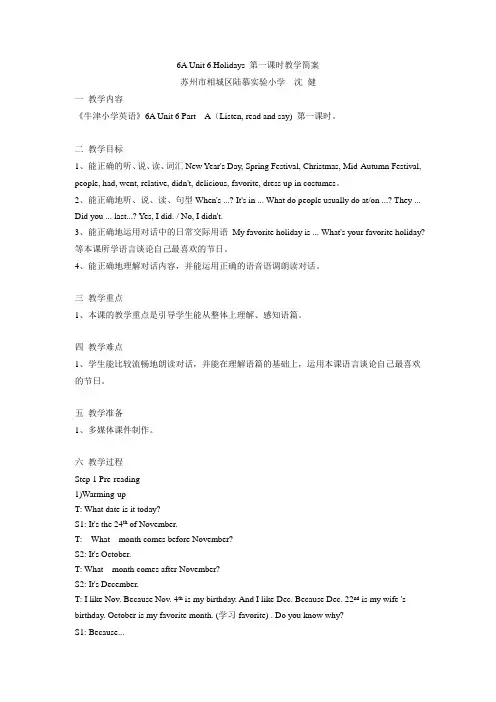
6A Unit 6 Holidays 第一课时教学简案苏州市相城区陆慕实验小学沈健一教学内容《牛津小学英语》6A Unit 6 Part A(Listen, read and say) 第一课时。
二教学目标1、能正确的听、说、读、词汇New Year's Day, Spring Festival, Christmas, Mid-Autumn Festival, people, had, went, relative, didn't, delicious, favorite, dress up in costumes。
2、能正确地听、说、读、句型When's ...? It's in ... What do people usually do at/on ...? They ... Did you ... last...? Yes, I did. / No, I didn't.3、能正确地运用对话中的日常交际用语My favorite holiday is ... What's your favorite holiday?等本课所学语言谈论自己最喜欢的节日。
4、能正确地理解对话内容,并能运用正确的语音语调朗读对话。
三教学重点1、本课的教学重点是引导学生能从整体上理解、感知语篇。
四教学难点1、学生能比较流畅地朗读对话,并能在理解语篇的基础上,运用本课语言谈论自己最喜欢的节日。
五教学准备1、多媒体课件制作。
六教学过程Step 1 Pre-reading1)Warming-upT: What date is it today?S1: It's the 24th of November.T: What month comes before November?S2: It's October.T: What month comes after November?S2: It's December.T: I like Nov. Because Nov. 4th is my birthday. And I like Dec. Because Dec. 22nd is my wife 's birthday. October is my favorite month. (学习favorite) . Do you know why?S1: Because...T: Because there's a long holiday in October. What is it?S2: The National Day holiday.T: Good. The National Day. It's a long holiday. We don't go to work or school. We can stay at home. Do many things we like. Yes? OK. Now, What do people usually do on National Day? (PPT 图片提示)S1: They usually...T: What did I do last National Day?S2: Did you ... last...? No, I didn't. (学习didn't.)T: OK. Let me show you: I went to Beijing. I visited the Bird's Nest and the Water Cube. They are great! I had a big lunch. The food is delicious.T: Today, Let's talk about holidays. (揭题,读题)2)Preview the text.(检查学生预习工作,出示课前的预习要求)1.听课文录音并试着跟读,重点注意生词的正确发音。
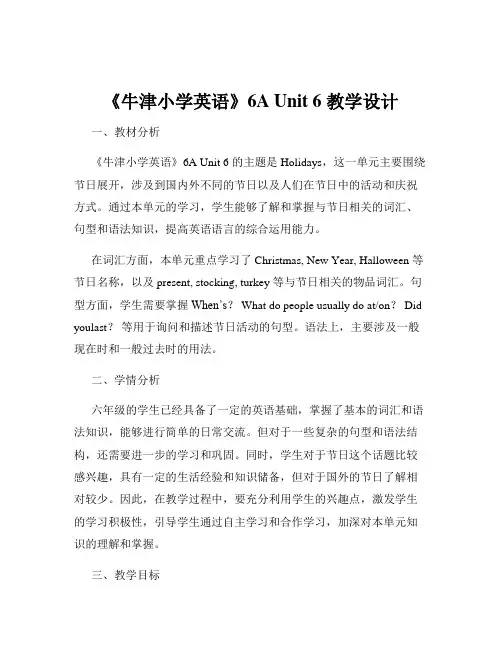
《牛津小学英语》6A Unit 6 教学设计一、教材分析《牛津小学英语》6A Unit 6 的主题是 Holidays,这一单元主要围绕节日展开,涉及到国内外不同的节日以及人们在节日中的活动和庆祝方式。
通过本单元的学习,学生能够了解和掌握与节日相关的词汇、句型和语法知识,提高英语语言的综合运用能力。
在词汇方面,本单元重点学习了 Christmas, New Year, Halloween 等节日名称,以及 present, stocking, turkey 等与节日相关的物品词汇。
句型方面,学生需要掌握When’s? What do people usually do at/on? Did youlast?等用于询问和描述节日活动的句型。
语法上,主要涉及一般现在时和一般过去时的用法。
二、学情分析六年级的学生已经具备了一定的英语基础,掌握了基本的词汇和语法知识,能够进行简单的日常交流。
但对于一些复杂的句型和语法结构,还需要进一步的学习和巩固。
同时,学生对于节日这个话题比较感兴趣,具有一定的生活经验和知识储备,但对于国外的节日了解相对较少。
因此,在教学过程中,要充分利用学生的兴趣点,激发学生的学习积极性,引导学生通过自主学习和合作学习,加深对本单元知识的理解和掌握。
三、教学目标1、知识目标(1)能听懂、会说、会读和会拼写单词 Christmas, New Year, Halloween, people, had, went, children, dress up, moon cake。
(2)能听懂、会说、会读单词 festival, relative, delicious, favourite, popular。
(3)能听懂、会说、会读和会写句型When’s? What do people usually do at/on? Did youlast?及其回答。
2、能力目标(1)能够运用所学句型询问和描述节日活动。

牛津小学英语6A教案(全册)课题:牛津英语6A教案Unit 1 Public signs第一课时教材类型:所属学科:英语>>6A(六上)☆教学调整☆教案内容:教学目标:1.能听懂、会说、会读和会拼写单词:mean, danger, should, shouldn’t, litter, park, cycle.2.能听懂、会说和会读单词和词组:public, a sign, grass, quiet, touch, keepoff.3.能听懂、会说、会读和会写句型:What does it meam? It means you shouldn’t …教学重点:1.能正确听说读会写句型:What does it meam? It means you shouldn’t …2.能正确能听说读写单词:mean, danger, should, shouldn’t, litter, park, cycle.教学过程:一. Everyday English:How are you?Pass the ball to …Give the pen to …Where’s …What’s the score?二.Presentation and practise:1. T: Let’s go the the park.(多媒体展示公园情景,出现许多公共标志牌)T: What’s this?It’s public signs.Learn : public signs.T: Let’s look at some public signs on the Internet.多媒体展示九个标志。
T: Can you read them?学生能朗读其中的八个:No parking. No eating and drinking. Keep quiet. Donot touch.通过复习帮助学生巩固以上四句话。
Park以前所学的意思是公园,在这里的意思是停车。
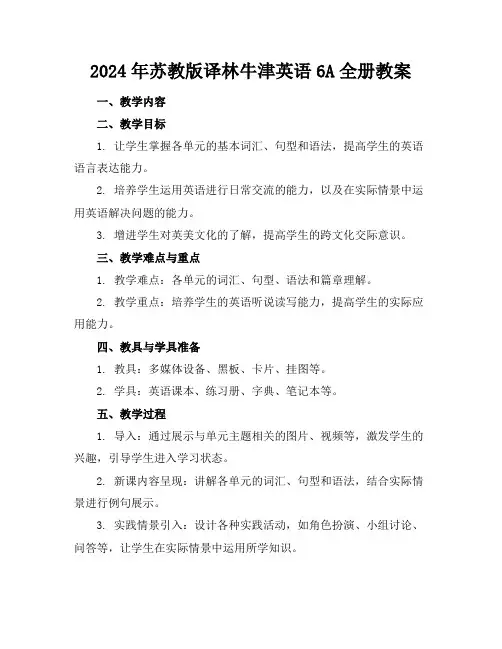
2024年苏教版译林牛津英语6A全册教案一、教学内容二、教学目标1. 让学生掌握各单元的基本词汇、句型和语法,提高学生的英语语言表达能力。
2. 培养学生运用英语进行日常交流的能力,以及在实际情景中运用英语解决问题的能力。
3. 增进学生对英美文化的了解,提高学生的跨文化交际意识。
三、教学难点与重点1. 教学难点:各单元的词汇、句型、语法和篇章理解。
2. 教学重点:培养学生的英语听说读写能力,提高学生的实际应用能力。
四、教具与学具准备1. 教具:多媒体设备、黑板、卡片、挂图等。
2. 学具:英语课本、练习册、字典、笔记本等。
五、教学过程1. 导入:通过展示与单元主题相关的图片、视频等,激发学生的兴趣,引导学生进入学习状态。
2. 新课内容呈现:讲解各单元的词汇、句型和语法,结合实际情景进行例句展示。
3. 实践情景引入:设计各种实践活动,如角色扮演、小组讨论、问答等,让学生在实际情景中运用所学知识。
4. 例题讲解:针对各单元的重点难点,进行例题讲解,帮助学生理解掌握。
5. 随堂练习:设计各种练习题,让学生巩固所学知识,并及时给予反馈。
六、板书设计1. 各单元主题及重点词汇、句型、语法。
2. 例题及解答过程。
3. 课后作业及拓展思考。
七、作业设计1. 作业题目:Write a short passage about public signs.Make a survey on how your classmates go to school.Describe your holiday activities.Write a letter to your friend about your summerholiday plans.2. 答案:见附录。
八、课后反思及拓展延伸2. 拓展延伸:鼓励学生进行课外阅读,观看英语动画片、电影等,提高学生的英语水平。
同时,引导学生关注英美文化,提高跨文化交际意识。
重点和难点解析一、教学内容1. 教材各单元的主题和词汇、句型、语法的讲解应结合实际情景,使学生在情境中更好地理解与运用。
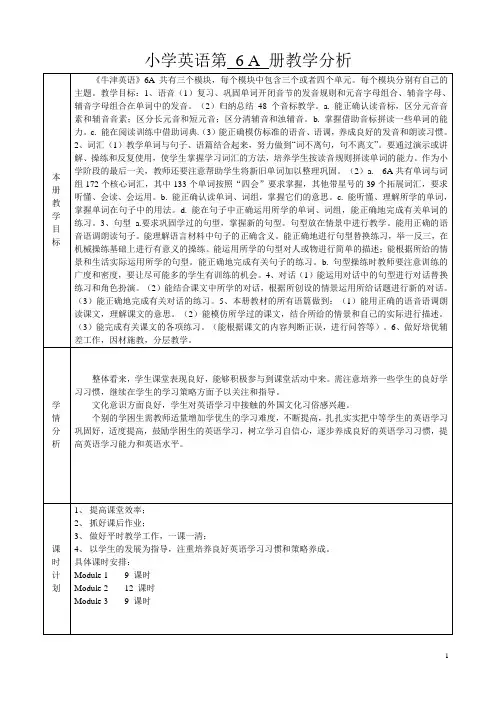
小学英语第6 A 册教学分析
胜利街小学学科进度表
2013.9 ——2014.1
1、各学科教师严格按照进度教学。
2、此表一式两份,交教研室一份,教师自留一份粘贴于备课本上。
教学设计首页
教学设计续页
教学设计首页
教学设计续页
教学设计首页
教学设计续页
教学设计首页
教学设计续页
教学设计首页
教学设计续页
教学设计首页
教学设计续页
教学设计首页
教学设计续页
教学设计首页
教学设计续页
教学设计首页
教学设计续页
教学设计首页
教学设计续页
教学设计首页
教学设计续页
教学设计首页
教学设计续页
教学设计首页
教学设计续页
教学设计首页
教学设计续页
教学设计首页
教学设计续页
教学设计首页
教学设计续页
教学设计首页
教学设计续页
教学设计首页
教学设计续页
教学设计首页
教学设计续页。
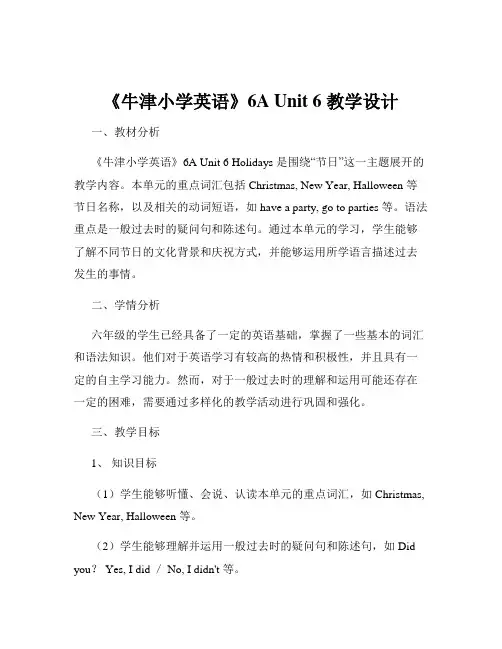
《牛津小学英语》6A Unit 6 教学设计一、教材分析《牛津小学英语》6A Unit 6 Holidays 是围绕“节日”这一主题展开的教学内容。
本单元的重点词汇包括 Christmas, New Year, Halloween 等节日名称,以及相关的动词短语,如 have a party, go to parties 等。
语法重点是一般过去时的疑问句和陈述句。
通过本单元的学习,学生能够了解不同节日的文化背景和庆祝方式,并能够运用所学语言描述过去发生的事情。
二、学情分析六年级的学生已经具备了一定的英语基础,掌握了一些基本的词汇和语法知识。
他们对于英语学习有较高的热情和积极性,并且具有一定的自主学习能力。
然而,对于一般过去时的理解和运用可能还存在一定的困难,需要通过多样化的教学活动进行巩固和强化。
三、教学目标1、知识目标(1)学生能够听懂、会说、认读本单元的重点词汇,如 Christmas, New Year, Halloween 等。
(2)学生能够理解并运用一般过去时的疑问句和陈述句,如 Did you? Yes, I did / No, I didn't 等。
2、能力目标(1)学生能够用英语描述不同节日的庆祝方式和活动。
(2)学生能够根据图片或提示,用一般过去时写一篇关于节日的短文。
3、情感目标(1)培养学生对不同文化的兴趣和尊重,增强文化意识。
(2)激发学生学习英语的兴趣,提高学习积极性。
四、教学重难点1、教学重点(1)掌握本单元的重点词汇和短语。
(2)理解并正确运用一般过去时。
2、教学难点(1)一般过去时的疑问句和陈述句的结构和用法。
(2)能够在实际情境中灵活运用所学语言。
五、教学方法1、情景教学法通过创设生动的节日情景,让学生在真实的语境中感受和学习语言。
2、任务驱动法布置各种任务,如小组讨论、写作等,让学生在完成任务的过程中提高语言运用能力。
3、游戏教学法通过游戏活动,激发学生的学习兴趣,巩固所学知识。
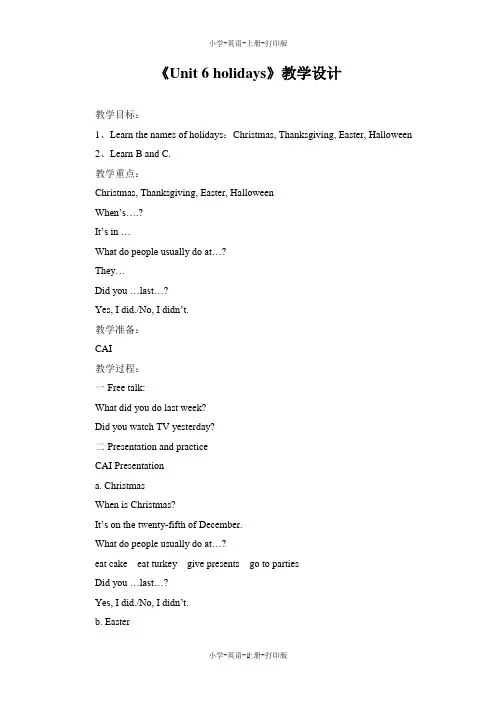
《Unit 6 holidays》教学设计教学目标:1、Learn the names of holidays:Christmas, Thanksgiving, Easter, Halloween2、Learn B and C.教学重点:Christmas, Thanksgiving, Easter, HalloweenWhen’s….?It’s in …What do people usually do at…?They…Did you …last…?Yes, I d id./No, I didn’t.教学准备:CAI教学过程:一Free talk:What did you do last week?Did you watch TV yesterday?二Presentation and practiceCAI Presentationa. ChristmasWhen is Christmas?It’s on the twenty-fifth of December.What do people usually do at…?eat cake eat turkey give presents go to partiesDid you …last…?Yes, I did./No, I didn’t.b. EasterWhen is Easter?It’s in March or in April.What do people usually do at…?colour some eggs look for eggs eat cake give presents Did you …last…?Yes, I did./No, I didn’t.c. HalloweenWhen is Halloween?It’s on the thirty-first of October.What do people usually do at…?go to parties dress up in costumes make pumpkin lanterns Did you …last…?Yes, I did./No, I didn’t.d. ThanksgivingWhen is Thanksgiving?It’s in November.What do people usually do at…?have parties sing and dance eat turkeyDid you …last…?Yes, I did./No, I didn’t.三ConsolidationPractise in pairs.四Homework1. Recite the phrases.2. Do the exercise.When’s….?It’s in …What do people usually do at…?They…Did you …last…?Yes, I did./No, I didn’t.五Writing on the blackboard.Unit 8Christmas, Thanksgiving, Easter, HalloweenWhen’s….?It’s in …What do people usually do at…?They…D id you …last…?Yes, I did./No, I didn’t.教后感:在本课的教学中我运用多媒体播放每个节日的场景,激起学生学习的兴趣,并联系起他们的日常生活,教学效果良好。
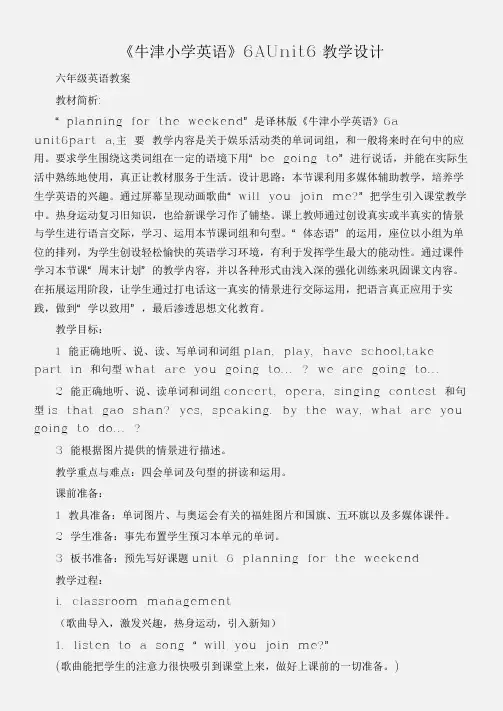
《牛津小学英语》6AUnit6教学设计六年级英语教案教材简析:“planning for the weekend”是译林版《牛津小学英语》6aunit6part a,主要教学内容是关于娱乐活动类的单词词组,和一般将来时在句中的应用。
要求学生围绕这类词组在一定的语境下用“be going to”进行说话,并能在实际生活中熟练地使用,真正让教材服务于生活。
设计思路:本节课利用多媒体辅助教学,培养学生学英语的兴趣。
通过屏幕呈现动画歌曲“will you join me?”把学生引入课堂教学中。
热身运动复习旧知识,也给新课学习作了铺垫。
课上教师通过创设真实或半真实的情景与学生进行语言交际,学习、运用本节课词组和句型。
“体态语”的运用,座位以小组为单位的排列,为学生创设轻松愉快的英语学习环境,有利于发挥学生最大的能动性。
通过课件学习本节课“周末计划”的教学内容,并以各种形式由浅入深的强化训练来巩固课文内容。
在拓展运用阶段,让学生通过打电话这一真实的情景进行交际运用,把语言真正应用于实践,做到“学以致用”,最后渗透思想文化教育。
教学目标:1 能正确地听、说、读、写单词和词组plan, play, have school,takepart in 和句型what are you going to... ? we are going to...2 能正确地听、说、读单词和词组concert, opera, singing contest 和句型is that gao shan? yes, speaking. by the way, what are you going to do... ?3 能根据图片提供的情景进行描述。
教学重点与难点:四会单词及句型的拼读和运用。
课前准备:1 教具准备:单词图片、与奥运会有关的福娃图片和国旗、五环旗以及多媒体课件。
2 学生准备:事先布置学生预习本单元的单词。
3 板书准备:预先写好课题unit 6 planning for the weekend教学过程:i. classroom management(歌曲导入,激发兴趣,热身运动,引入新知)1. listen to a song “will you join me?”(歌曲能把学生的注意力很快吸引到课堂上来,做好上课前的一切准备。
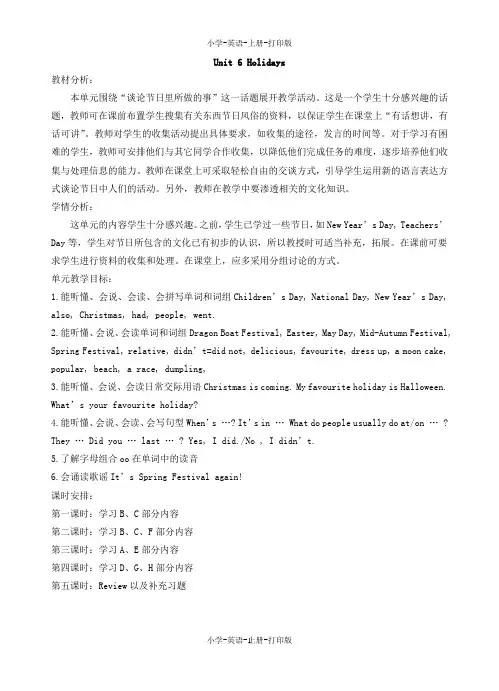
Unit 6 Holidays教材分析:本单元围绕“谈论节日里所做的事”这一话题展开教学活动。
这是一个学生十分感兴趣的话题,教师可在课前布置学生搜集有关东西节日风俗的资料,以保证学生在课堂上“有话想讲,有话可讲”。
教师对学生的收集活动提出具体要求,如收集的途径,发言的时间等。
对于学习有困难的学生,教师可安排他们与其它同学合作收集,以降低他们完成任务的难度,逐步培养他们收集与处理信息的能力。
教师在课堂上可采取轻松自由的交谈方式,引导学生运用新的语言表达方式谈论节日中人们的活动。
另外,教师在教学中要渗透相关的文化知识。
学情分析:这单元的内容学生十分感兴趣。
之前,学生已学过一些节日,如New Year’s Day, Teachers’ Day等,学生对节日所包含的文化已有初步的认识,所以教授时可适当补充,拓展。
在课前可要求学生进行资料的收集和处理。
在课堂上,应多采用分组讨论的方式。
单元教学目标:1.能听懂、会说、会读、会拼写单词和词组Children’s Day, National Day, New Year’s Day, also, Christmas, had, people, went.2.能听懂、会说、会读单词和词组Dragon Boat Festival, Easter, May Day, Mid-Autumn Festival, Spring Festival, relative, didn’t=did not, delicious, favourite, dress up, a moon cake, popular, beach, a race, dumpling,3.能听懂、会说、会读日常交际用语Christmas is coming. My favourite holiday is Halloween. What’s your favourite holiday?4.能听懂、会说、会读、会写句型When’s …? It’s in … What do people usually do at/on … ? They … Did you … last …? Yes, I did./No , I didn’t.5.了解字母组合oo在单词中的读音6.会诵读歌谣It’s Spring Festival again!课时安排:第一课时:学习B、C部分内容第二课时:学习B、C、F部分内容第三课时:学习A、E部分内容第四课时:学习D、G、H部分内容第五课时:Review以及补充习题。
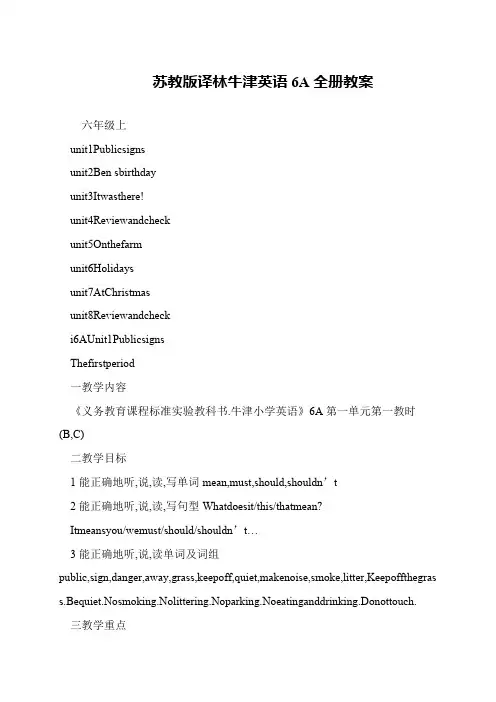
《牛津小学英语》6A Unit 6《牛津小学英语》6A Unit6《牛津小学英语》6A Unit 6《牛津小学英语》6A Unit 6《牛津小学英语》6A Unit 6第六课时 Practice1.教师把练习题抄在黑板上。
2.学生独立思考并完成。
3.集体校对,纠正。
4.学生自己重新审视错题,进行反思。
Exercises:一、判断划线部分发音是否一致,相同(S)不同(D)1. moon foot ( )2. year bear( )3. where there( )4. visited wanted( )5. food room( )二、按要求写单词1.go(过去式)______________ 2.get(现在分词)_______________3. children(单数)____________4. want(过去式)______________5. too (同音词)______________6.teachers(名词所有格)__________7. party(复数)_______________e after(反义词组)____________ 9.had(原形)________________ 10.there(同音词)_________________三、中英文互译1.在春节_____________________2.赏月______________________3.美味的食物_________________4.上个元旦___________________5.他特别喜爱的节日______________6.dress up in costumes____________7.dragon boat races_____________8.at Easter _______________9.make pumpkin lanterns_________10、a popular holiday______________四、用动词的适当形式填空1.What time _______ Mr Smith __________(have) supper every day?2.I’d __________(like) a football as my Christmas present.I like __________(play) football.3.Ben _____________(go) to a party last Halloween.4.--____________you __________(watch) the moon last year?--Yes, it ______(be) beautiful.5.What ________ children doing? They _______________(make) lanterns. 五.句型转换1. They went there by bus.( 对划线部分提问)they there?2 .Children like to play with lanterns.( 同义句)Children like lanterns.3. Mr Green is talking to his students about Holidays.(改成过去时态) Mr Green his students about holidays.4 .Christmas is on the 25th of December. ( 对划线部分提问)Christmas.5 .I had a big lunch with my family. ( 改为否定句)I _________ a big lunch with my family.六.选择题( )1.Did Su Hai eat rice dumplings __ Dragon Boat festival ___Wednesday?A. on;onB. at;onC. at;inD. at;at( ) 2.When’s Halloween?A.It’s in November.B. It’s in January.C. It’s in October.D. It’s in April.( ) 3.Christmas is ______.What holiday ______ after Christmas?A. come;comeB. come;comesC. coming;comeD. coming;comes( ) 4. I _____ lots of ___________ last Friday.A. eat;moon cakesB. ate;moon cakeC. ate;delicious foodD. ate;delicious foods( ) 5. These presents are Mike and Helen’s. Give ____ to _____.A. them;theyB. they;theyC.them;themD. they;them( ) 6.What does he do in the morning? He usually _____ his English book.A. looksB. readsC. watchesD. looks at( )7.What do people usually do ___New Year’s Day and ___Spring Festival?A. in;onB. at;onC. on;inD. on;at( )8 .I usually ____my homework in the evening.But yesterday I ___it in the afternoon.A. does;doB. do;didC. did;doD. do;does( ) 9. Where _____ Su Yang and her mother last weekend?A. wasB. areC. wereD. is( )10.Gao Shan and Wang Bing are in ____school but in _____ classes.A. same; differentB. the same; the differentC. the same; differentD. same; the different七.根据汉语意思,翻译下列各句1.昨天你们举行跑步比赛了么?是的,我们举行了。
6A Unit6 Holidays教案东余小学龚佩一、教学内容《牛津小学英语》6A unit6 Holidays第一教时(BC)。
二、教学目标1、能正确地听、说、读、写词汇New Year’s Day, Children’s Day, Halloween...2、能正确地听、说、读词汇Spring Festival, Mid-Autumn Festival, Easter, May Day, National Day, Dragon Boat Festival,3、能正确地听、说、读、写句型What do people usually do at …?They…4、能正确地理解、掌握对话内容,并进行简单的表演。
5、能运用本教时所教的内容谈论自己最喜欢的节日。
三、教学重点、难点能运用本教时所教的内容谈论自己最喜欢的节日。
四、课前准备1、单词、句型卡片。
2、多媒体教学课件。
3、表格。
(每人一张)五、教学过程Step1:Warm upA. Listen to a songB. Free talkT: What day is it today?What date is it today?What do you usually do on Sundays?When’s your birthday?Step2:Presentation and consolidation1. T: Today we’ll learn Unit6 Holidays. 板书:Holidays2.T: Look at the screen. What date is it ?(出示一些日期,和学生熟悉的节日名称)S1: It’s…T: What holiday is it? Do you know?S2: It’s…(Women’s Day, Nurses’ Day, Teachers’ Day, Children’s Day, Halloween)T: When’s …?S3: It’s on …T: We can also say ‘ It’s in May/…’板书:When’s …? It’s in…Ask and answer When’s…? It’s in…3. T: Now let’s listen to the m usic then guess what holiday, you can say in Chinese.Teach: Children Day, May Day, National Day, New Year’s DayT: When’s …Day?S: It’s in…T: What do you usually do on …?S1: I usually…Practice in pairsT: on Children’s Day/May Day/National Day/New Year’s Day4.Chant5.T: Look at the picture, what holiday is it?Teach: Easter/Hallow/Mid-Autumn Festival/Dragon Boat Festival/Spring Festival 同时介绍有关节日名称的由来。
苏教版(凤凰)牛津英语教案20116A Unit6 教学方案(第二课时)第一部分简要提示一、年级:六年级二、单元:Unit6三、课题:Holidays四、课型:新授课五、教学内容:Part BCD六、教学目标:⒈掌握单词、词组:Easter, May Day, Children’s Day, National Day, Dragon BoatFestival, eat a lot of delicious food, dress up in costumes, watch the moon.⒉进一步巩固掌握句型:When’s...? It's in ... What do people usually do at/on...?They ... Did you ... last...? Yes, I did. / No, I didn't.七、重点、难点:1、各节日读法及意义。
2、进一步巩固掌握句型:When’s...? It's in ... What do people usually do at/on ...? They ... Did you ... last...? Yes, I did. / No, I didn't.第二部分教学过程用时:25分钟第一步:复习课文用时:5 分钟T: Hello, boys and girls. Nice to meet you. 很高兴再次与你见面。
Last lesson, we learned something about holidays. 上节课我们一起了解了有关节日的一些知识。
Now let’s watch the cartoon again and review. 现在,我们一起再来看一遍动画,回顾一下吧。
(PPT课文动画)T:OK. Do you remember the following holidays? 你还记得以下节日么?(PPT显示五个节日图与字) Good, they are Christmas, Halloween, New Year's Day, Spring Festival, and Mid-Autumn Festival. Can you answer my questions?(PPT)T: When's Mid-Autumn Festival?T: What do people usually do at Mid-Autumn Festival?T: Did you play with lanterns last Mid-Autumn Festival?T: Now, can you make dialogues like this? 你会不会像这样编个对话呢?Please use the following sentences: (PPT: When’s...? It's in ... What do people usually do at/on ...? They ... Did you ... last...? Yes, I did. / No, I didn't.) Choose one of them, and workwith your partner.(本步骤设计说明:本课时重点学习九个节日名称,其中有四个已在A部分出现并学习过,因此在本环节,教师安排对这几个节日的名称进行复习,从而引出话题—谈论这些节日,即巩固了旧知,在复习旧知的基础上为将要学习的五个新的节日做铺垫。
苏教版(凤凰)牛津英语教案20116B Unit3 (Part A) 教学方案年级:6年级单元:Unit 3课题:Asking the way 课型:新授课教学目标: 1. 掌握单词、词组way, get off, along, street, take, stop, road, history, museum, crossing, miss, kilometer, No.2. 能听懂、会说、会读日常交际用语Go along this street, and thenturn right at the third crossing. How far is it from here? It’s about akilometer away. You can take bus No. 5. How many stops arethere?重点难点:初步了解掌握句型:Can you tell me the way to….please?教学过程用时:25分钟第一步:重难点突破用时:10分钟1.T: (PPT 1 显示课题) Hello, boys and girls. Nice to meet you.T: Today we are going to learn. Unit Three - Asking the way 出示课题:Now , please read after me: way (两遍) 路。
道路。
ay/ei/Asking the way. (两遍) 问路2.T: OK. You know I’m your new teacher. Where is your school? Can you tell me the way to your school? 你能告诉我去你们学校的路吗?Here, Can you tell me the way to…,please?意思是:请问你能告诉我去某个地方的路怎么走吗?T: Please read after me. (带读句子两遍),请同学们注意看老师口形下面,我们就试着来用一用这个句子:Look at this boy. 这个男孩想去公园,但他不认识路,他该怎么说?Yes, he can say: Can you tell me the way to the park,please?(你可以告诉我去公园的路吗?) (出示句子)。
牛津英语6A全册教案一、教学内容本节课的教学内容选自牛津英语6A教材,包括Unit 1Unit 6十个单元。
教学内容主要围绕着日常生活中的话题展开,如学校生活、家庭成员、节日庆祝、购物、旅行、天气、体育活动等。
每个单元由几个模块组成,包括词汇、语法、听力、口语、阅读和写作等。
二、教学目标1. 学生能够掌握教材中的词汇、语法和功能句型,并在实际情景中运用。
2. 学生能够提高听力、口语、阅读和写作能力,达到相应的教学目标。
三、教学难点与重点重点:教材中的词汇、语法和功能句型的学习和运用。
难点:听力、口语、阅读和写作能力的提高,以及在学习过程中遇到的生词和短语的理解。
四、教具与学具准备教具:PPT、黑板、粉笔、录音机、磁带或音频文件。
学具:课本、练习册、铅笔、橡皮、笔记本。
五、教学过程1. 热身(5分钟)教师与学生进行简单的英语对话,询问学生上一节课的学习内容,检查学生的学习情况。
然后,引导学生进行小组活动,讨论彼此的学习心得。
2. 导入(10分钟)教师通过PPT展示本节课的主题,引导学生回顾相关话题的词汇和短语。
然后,引入本节课的新内容,激发学生的学习兴趣。
3. 课堂讲解(20分钟)教师讲解本节课的词汇、语法和功能句型,并通过例句和练习进行讲解。
同时,引导学生参与课堂讨论,巩固所学知识。
4. 课堂练习(15分钟)学生根据教师给出的任务,进行听力、口语、阅读和写作的练习。
教师巡回指导,解答学生的疑问,并给予鼓励和评价。
5. 小组活动(10分钟)学生分组进行活动,运用所学知识进行对话和讨论。
教师观察学生的表现,及时给予指导和评价。
7. 课后作业布置(5分钟)教师布置作业,包括词汇练习、语法练习、听力练习和阅读写作任务。
同时,提醒学生按时完成作业,并给予解答。
六、板书设计教师根据课堂讲解的内容,设计板书,突出关键词汇、语法和功能句型。
板书设计简洁明了,便于学生理解和记忆。
七、作业设计1. 词汇练习:根据本节课所学词汇,完成填空、选择、翻译等练习。
从生活中来到生活中去———《牛津小学英语》6A Unit6A部分教学设计一.教学内容<牛津小学英语>6A Unit 6 A部分二.教学目标⒈ 知识目标⑴初步掌握单词、词组:Christmas, Halloween, New Year's Day, Spring Festival,Mid-Autumn Festival, people, didn't, had, relative, delicious, favourite, dress up, went, moon cake.⑵能听懂、会说、会读日常交际用语:Christmas is coming. What's yourfavourite holiday? My favourite holiday is Halloween.2.技能目标⑴能根据阅读的目的,运用恰当的阅读策略,克服生词障碍,理解大意。
⑵能在学习中互相帮助,克服困难,共同完成学习任务。
三.教学重难点初步了解并掌握句型:1.When's ...? It's in ...2.What do people usually do at/on ...? They ...3.Did you ... last...? Yes, I did. / No, I didn't.四.教具准备1.教师准备:录音机,图片,课件2.学生准备:课前预习,搜集与要学节日有关的信息。
五.教学过程Step1.Warm-up1.Listen and sing.<Wish you a Merry Christmas>(学生观看Flash动画)[设计思路]旋律优美的音乐很容易将学生的注意力吸引到课堂中,不但创设了一种美好的英语氛围,而且让学生能初步感受到本节课的学习内容。
2.Free talk.T: What date is it today?T: When is your birthday?T: What did you do last birthday?T: Did you have a birthday party?T: My birthday is on the 25th of December. Do you know it’s also Christmas Day? T: Do you know other holidays?(板书课题Unit6 Holidays)[设计思路]利用Daily report,慢慢引出本节课的学习内容,自然流畅。
苏教版(凤凰)牛津英语教案20116A Unit6 教学方案(第一课时)第一部分简要提示一、年级:六年级二、单元:Unit6三、课题:Holidays四、课型:新授课五、教学内容:Part A六、教学目标:⒈掌握单词、词组:Christmas, Halloween, New Year's Day, Spring Festival,Mid-Autumn Festival, people, didn't, had, relative, delicious, favourite, dress up, went, moon cake.⒉能听懂、会说、会读日常交际用语:Christmas is coming. What's yourfavourite holiday? My favourite holiday is Halloween.七、重点、难点:初步了解并掌握句型:When's ...? It's in ... What do peopleusually do at/on ...? They ... Did you ... last...? Yes, I did. / No, I didn't.第二部分教学过程第一步:重难点突破T: Hello, boys and girls. Nice to meet you. 同学们,你们好。
Today we are going to learn Unit 6 Holidays. 今天我们将共同学习第六单元—节日。
Let's begin our class, OK?Which holiday do you know? 你所了解的节日有那些?(稍停)好,我们先来认识一下这几个常见节日。
(PPT图片) What holiday is this? It’s New Year's Day. New Year's Day春节。
(拿出卡片)Now please look and read after me. 请看卡片,并且主义我的口型,跟我模仿。
(慢读2遍)again (快读一遍) (PPT图片,同样方法学习新词Halloween, Spring Festival, Mid-Autumn Festival,教授。
每词三遍。
)T: There are many holidays.(PPT)What’s your favourite holiday? 你最喜欢什么节日?(教授favourite 最爱的,慢读,示范发音。
简单释义:your favourite person or thing is the one that you like the most.) 请跟我读:What’s your favourite holiday?(2遍)You can answer: My favourite holiday is …For example: My favourite holiday is Spring Festival.T: (PPT圣诞节动画) Look, what holiday is this? 这是什么节日呢?T: Yes, it's Christmas.(重复读)圣诞节。
My favourite holiday is Christmas.(PPT 显示句型)When's Christmas? 圣诞节是什么时间呢?T: Right, it's on the 25th of December. It’s in the December.T: What do you usually do at Christmas? 你通常在圣诞节做些什么事情呢?What do people usually do at Christmas? 人们通常在圣诞节做些什么呢?(稍停, 教读)They …T:(PPT显示短语)Maybe they buy Christmas presents, have a big lunch, go to a party, sing and dance ...T: You can ask and answer like this: What do people usually do at Christmas? They go to a party.T: Did you go to a party last Christmas? 上个圣诞节你去聚会了么?(重复,慢读)If you did, you may say: Yes, I did. (重复) If you did not, you may say: No, I didn’t.(重复)T: (PPT显示句型)Did you go to a party last Christmas?Yes, I did. / No, I didn't.T: Now, you can ask your classmates like this. (PPT出句型) 现在请你像这样与同伴练习问答。
(本步骤设计说明:课文生词较多,要求学生掌握的句型也较多,设计此Free talk 是为了要在看似不经意之中通过聚焦谈论Christmas这一节日把本课重点句型进行渗透,窥一斑而知全豹,为学习其他节日埋下伏笔,在轻松的聊天气氛中帮助学生理解新知,减轻课文学习的难度。
)第二步:课文学习1、前言T: (PPT出示图上课情景和前言) Boys and girls, look, the students are having an English lesson. Mr Green is their English teacher. Now please read this passage, then answer my questions. 请你听录音看文字,试着找出这些问题的答案。
(PPT 出示四个问题)(学生听录音读前言半分钟。
)T: OK, now can you tell me: what date is it? (稍停顿,点出答案:It’s the 18th of December.)T: The second question: Which festival is coming? (稍停顿,点出答案:Christmas is coming.)Christmas is coming. That means: 圣诞节快要到了。
(重复慢读)那么,“万圣节快要到了”用英语该如何表达呢?(稍停)对了,Halloween is coming. 同样的,“国庆节快要到了”又该怎么说呢?请你来试试看。
(稍停)T: Good. 回答的很好。
National Day is coming.T: Well. The third question: How are the teachers and the students? (稍停顿,点出答案:They are getting very excited.)T: The last question: What is Mr Green doing? (稍停顿,点出答案:He’s talking to his students about holidays.)T: Now can you read it by yourself? Have a try. 现在请你来试着读一读这部分吧。
Please.2、正文T: OK. Now we know Mr Green is talking to his students about holidays. 现在我们已经知道Mr Green 正在和他的学生们谈论有关节日的话题。
What holidays are they talking about? 请看课文动画,看看能不能找出文中所提到的节日。
Ready? Let’s go. (PPT动画一分钟。
)T: 你找到了么?来看看你的答案与老师的一致么?(PPT显示第一栏正确答案, 教读四个节日。
注意口型示范。
)(PPT显示表格第二栏)T: When’s New Year’s Day?T: Yes, it’s in January.T: When’s Spring Festival? (稍停) Right, it’s in January or February.T: What about Halloween? (稍停) Good, Halloween is in October.T: When’s Mid-Autumn Festival? (稍停) It’s in September or October.T: Are you right? 相信你也一定答对了吧。
Well, what do people usually do at those holidays? 人们通常在以上节日中会做些什么呢?Now please listen to it again, and then answer my questions. 请仔细听对话,试着完成表格第三栏。
(PPT)表格T:你完成的怎么样?让我们来看看正确答案。
请跟我读这些词和词组delicious,relatives,dress up, moon cake, watch the moon 简单解释词义)Relatives, that means members of your family. 亲戚。
Delicious, that means very pleasant to taste or smell.可口的,美味的。
Dress up,装扮,for example: dress up in costumes, 教读)T: Now work in pairs. Make dialogues like this 现在,请仿照下面的例句做对话:A: When’s New Year’s Day?B: It’s in January.A: What do people usually do on New Year’s Day?A: They go to parties and have a big lunch.现在请同学们两人一组,用所给句型进行交换问答。
请先跟我读读这几个句子。
下面开始吧。
T: Good. Did David go to parties last year? David 去年有没有去参加聚会呢?读正文1~6行,然后回答问题:Did David go to parties last year?(稍停)T: No, he didn’t. (PPT)He had a big lunch with his family last year. (点击出现句子,教have的过去式had.) (PPT显示have的三种时态进行比较,读例句。